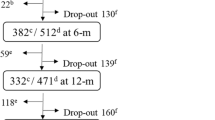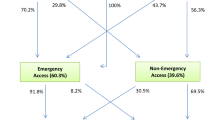Abstract
Relapses may represent a critical hazard in schizophrenia spectrum disorders as they are associated with an increased risk of a clinical and functional deterioration. Preventing relapse after recovering from a first psychotic episode has become a major challenge due to its critical impact on lifelong functionality. This study explored the rate of first and second relapses and the predictors associated with these relapses in a large cohort of non-affective psychosis patients during a period of 3 years after the first break of the illness. From February 2001 to May 2014, sociodemographic and clinical data from an epidemiological cohort of 341 non-affective first-episode psychosis patients at risk of relapse were analysed at a specialized early intervention service. Logistic regression, Cox regression, and Kaplan–Meier survival analyses were performed to compare non-relapsed and relapsed patients. One hundred and sixty-six (48.7%) individuals relapsed at least once. Median time to relapse was 17.0 months in non-adherent patients and 40.0 months in adherent patients (log-rankχ 2: 51.36; p < 0.001). Non-adherence to medication (odds ratio-OR 2.979; p < 0.001), schizophrenia diagnosis (OR 2.173; p = 0.002), and age of onset (OR 1.020; p = 0.033) were the main predictors of the first relapse. Fifty-six subjects experienced a second relapse (33.73%) predicted by diagnosis (OR 1.975; p = 0.074), age of onset (OR 1.078; p = 0.003), and positive symptoms (OR 0.863; p = 0.03), but not adherence. Non-adherence is the main predictive factor of first relapse after a first episode of psychosis. Second relapses were not often and not related to modifiable factors, suggesting that multiple relapsed patients may comprise a subgroup with a higher biological risk.



Similar content being viewed by others
References
Kane JM (2007) Treatment strategies to prevent relapse and encourage remission. J Clin Psychiatry 68(Suppl 1):27–30
Wyatt RJ (1997) Research in schizophrenia and the discontinuation of antipsychotic medications. Schizophr Bull 23:3–9
Wiersma D, Nienhuis FJ, Slooff CJ, Giel R (1998) Natural course of schizophrenic disorders: a 15-year followup of a Dutch incidence cohort. Schizophr Bull 24:75–85
Lieberman J, Jody D, Geisler S et al (1993) Time course and biologic correlates of treatment response in first-episode schizophrenia. Arch Gen Psychiatry 50:369–376
Andreasen NC, Liu D, Ziebell S et al (2013) Relapse duration, treatment intensity, and brain tissue loss in schizophrenia: a prospective longitudinal MRI study. Am J Psychiatry 170:609–615. doi:10.1176/appi.ajp.2013.12050674
Amore M, Menchetti M, Tonti C et al (2008) Predictors of violent behavior among acute psychiatric patients: clinical study. Psychiatry Clin Neurosci 62:247–255. doi:10.1111/j.1440-1819.2008.01790.x
Hor K, Taylor M (2010) Suicide and schizophrenia: a systematic review of rates and risk factors. J Psychopharmacol 24:81–90. doi:10.1177/1359786810385490
Masand PS, Roca M, Turner MS, Kane JM (2009) Partial adherence to antipsychotic medication impacts the course of illness in patients with schizophrenia: a review. Prim Care Companion J Clin Psychiatry 11:147–154. doi:10.4088/PCC.08r00612
Kane JM (2007) Treatment adherence and long-term outcomes. CNS Spectr 12:21–26
Hong J, Windmeijer F, Novick D et al (2009) The cost of relapse in patients with schizophrenia in the European SOHO (Schizophrenia Outpatient Health Outcomes) study. Prog Neuropsychopharmacol Biol Psychiatry 33:835–841. doi:10.1016/j.pnpbp.2009.03.034
Robinson D, Woerner MG, Alvir JMJ et al (1999) Predictors of relapse following response from a first episode of schizophrenia or schizoaffective disorder. Arch Gen Psychiatry 56:241. doi:10.1001/archpsyc.56.3.241
Zipursky RB, Menezes NM, Streiner DL (2014) Risk of symptom recurrence with medication discontinuation in first-episode psychosis: a systematic review. Schizophr Res 152:408–414. doi:10.1016/j.schres.2013.08.001
Caseiro O, Pérez-Iglesias R, Mata I et al (2012) Predicting relapse after a first episode of non-affective psychosis: a three-year follow-up study. J Psychiatr Res 46:1099–1105. doi:10.1016/j.jpsychires.2012.05.001
Birchwood M, Todd P, Jackson C (1998) Early intervention in psychosis. The critical period hypothesis. Br J Psychiatry Suppl 172:53–59
Mayoral-van Son J, de la Foz VO-G, Martinez-Garcia O et al (2015) Clinical outcome after antipsychotic treatment discontinuation in functionally recovered first-episode nonaffective psychosis individuals. J Clin Psychiatry. doi:10.4088/JCP.14m09540
Alvarez-Jimenez M, Priede A, Hetrick SE et al (2012) Risk factors for relapse following treatment for first episode psychosis: a systematic review and meta-analysis of longitudinal studies. Schizophr Res 139:116–128. doi:10.1016/j.schres.2012.05.007
Pelayo-Terán JM, Pérez-Iglesias R, Ramírez-Bonilla M et al (2008) Epidemiological factors associated with treated incidence of first-episode non-affective psychosis in Cantabria: insights from the Clinical Programme on Early Phases of Psychosis. Early Interv Psychiatry 2:178–187. doi:10.1111/j.1751-7893.2008.00074.x
Crespo-Facorro B, Pérez-Iglesias R, Ramirez-Bonilla M et al (2006) A practical clinical trial comparing haloperidol, risperidone, and olanzapine for the acute treatment of first-episode nonaffective psychosis. J Clin Psychiatry 67:1511–1521. doi:10.4088/JCP.v67n1004
First MB, Spitzer RL, Gibbon M, Williams JBW (2001) Structured Clinical Interview for DSM-IV Axis I disorders (clinician version). New York State Psychiatric Institute Biometrics Department, New York
Guy W (1976) CGI. Clinical global impression. In: Guy W (ed) ECDEU assess. Man. Psychopharmacol. Revis, pp 217–222
Overall JE, Gorham DR (1962) The brief psychiatric rating scale. Psychol Rep 10:799–812. doi:10.2466/pr0.1962.10.3.799
Andreasen NC (1984) Scale for the Assessment of Positive Symptoms (SAPS). University of Iowa, Iowa City
Andreasen NC (1983) Scale for the Assessment of Negative Symptoms (SANS). University of Iowa, Iowa
Addington D, Addington J, Maticka-Tyndale E (1993) Assessing depression in schizophrenia: The Calgary depression scale. Br J Psychiatry 22:39–44
Young RC, Biggs JT, Ziegler VE, Meyer DA (1978) A rating scale for mania: reliability, validity and sensitivity. Br J Psychiatry 133:429–435
Crespo-Facorro B, Pérez-Iglesias R, Mata I et al (2011) Relapse prevention and remission attainment in first-episode non-affective psychosis. A randomized, controlled 1-year follow-up comparison of haloperidol, risperidone and olanzapine. J Psychiatr Res 45:763–769. doi:10.1016/j.jpsychires.2010.11.002
Hollingshead A, Redlich F (1958) Social class and mental illness: a community study. Wiley, New York
Amador XF, Flaum M, Andreasen NC et al (1994) Awareness of illness in schizophrenia and schizoaffective and mood disorders. Arch Gen Psychiatry 51:826–836
Cannon-Spoor HE, Potkin SG, Wyatt RJ (1982) Measurement of premorbid adjustment in chronic schizophrenia. Schizophr Bull 8:470–484
van Mastrigt S, Addington J (2002) Assessment of premorbid function in first-episode schizophrenia: modifications to the Premorbid Adjustment Scale. J Psychiatry Neurosci 27:92–101
Robinson DG, Woerner MG, Alvir JM et al (1999) Predictors of treatment response from a first episode of schizophrenia or schizoaffective disorder. Am J Psychiatry 156:544–549
Malla A, Norman R, Bechard-Evans L et al (2008) Factors influencing relapse during a 2-year follow-up of first-episode psychosis in a specialized early intervention service. Psychol Med 38:1585–1593. doi:10.1017/S0033291707002656
Craig TKJ, Garety P, Power P et al (2004) The Lambeth Early Onset (LEO) team: randomised controlled trial of the effectiveness of specialised care for early psychosis. BMJ 329:1067. doi:10.1136/bmj.38246.594873.7C
Coldham EL, Addington J, Addington D (2002) Medication adherence of individuals with a first episode of psychosis. Acta Psychiatr Scand 106:286–290
Addington DE, Patten SB, McKenzie E, Addington J (2013) Relationship between relapse and hospitalization in first-episode psychosis. Psychiatr Serv 64:796–799. doi:10.1176/appi.ps.201200440
Emsley R, Chiliza B, Asmal L, Harvey BH (2013) The nature of relapse in schizophrenia. BMC Psychiatry 13:50. doi:10.1186/1471-244X-13-50
Wunderink L, Nienhuis FJ, Sytema S et al (2007) Guided discontinuation versus maintenance treatment in remitted first-episode psychosis: relapse rates and functional outcome. J Clin Psychiatry 68:654–656. doi:10.4088/JCP.v68n0502
Hui CL-M, Tang JY-M, Leung C-M et al (2013) A 3-year retrospective cohort study of predictors of relapse in first-episode psychosis in Hong Kong. Aust NZ J Psychiatry 47:746–753. doi:10.1177/0004867413487229
Acknowledgements
The present study was carried out at the Hospital Marqués de Valdecilla, University of Cantabria, Santander, Spain, under the following grant support: Instituto de Salud Carlos III PI020499, PI050427, PI060507, Plan Nacional de DROGAS Research Grant 2005- Orden sco/3246/2004, SENY Fundació Research Grant CI 2005-0308007, Fundación Marqués de Valdecilla API07/011 and CIBERSAM. Unrestricted educational and research grants from AstraZeneca, Pfizer, Bristol-Myers Squibb, and Johnson & Johnson provided support to PAFIP activities. No pharmaceutical industry has participated in the study concept and design, data collection, analysis and interpretation of the results, and drafting the manuscript. PAFIP II is registered as a clinical trial (NCT02305823) in Clinicaltrials.gov: “Comparative Study of Aripiprazole, Quetiapine and Ziprasidone in the Treatment of First-Episode Non-affective Psychosis” (AZQ2005). The study, designed and directed by B C-F and JL V-B, conformed to international standards for research ethics and was approved by the local institutional review board. We wish to thank the PAFIP researchers who helped with data collection. In addition, we acknowledge the participants and their families for enrolling in this study.
Author information
Authors and Affiliations
Corresponding author
Ethics declarations
Conflict of interest
Dr. José María Pelayo-Terán has received lecture honoraria and travel support form Janssen Johnson & Johnson, Lundbeck, Otsuka Pharmaceuticals, GlaxoSmithkline and EiLilly. Prof. Benedicto Crespo-Facorro has received honoraria for consulting/advisory boards from Otsuka Pharmaceuticals and lecture honoraria from Janssen Johnson & Johnson, Lundbeck, Roche and Otsuka Pharmaceuticals. Prof. Rafael Tabarés-Seisdedos has received grants from or acted as a consultant for the following companies: AstraZeneca, Janssen, Eli- Lilly, Lundbeck, Novartis, Pfizer, Sanofi-Aventis, and Wyeth that were deposited into research accounts at the University of Valencia. Dr.Virginia Gajardo Gajardo Galán, Víctor de la Ortiz-García de la Foz, Obdulia Martín-García and Dr. Rosa Ayesa-Arriola report no additional financial support or other relationship relevant to the subject of this article.
Additional information
José María Pelayo-Terán and Virginia Gajardo Gajardo Galán have contributed equally to this article.
Rights and permissions
About this article
Cite this article
Pelayo-Terán, J.M., Gajardo Galán, V.G., de la Ortiz-García de la Foz, V. et al. Rates and predictors of relapse in first-episode non-affective psychosis: a 3-year longitudinal study in a specialized intervention program (PAFIP). Eur Arch Psychiatry Clin Neurosci 267, 315–323 (2017). https://doi.org/10.1007/s00406-016-0740-3
Received:
Accepted:
Published:
Issue Date:
DOI: https://doi.org/10.1007/s00406-016-0740-3




